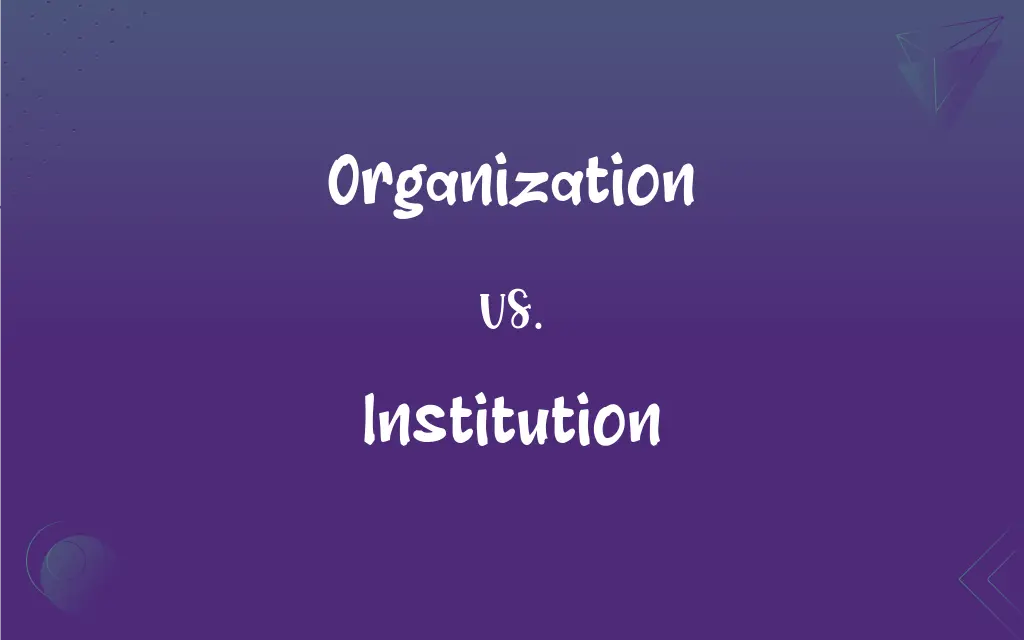Organization vs. Institution: What's the Difference?
Edited by Janet White || By Harlon Moss || Updated on October 2, 2023
Organization refers to a group structured and coordinated to meet certain objectives, while Institution is a long-standing structure or mechanism in society with a specific purpose.

Key Differences
An organization is typically understood as any entity that involves people and resources that function cohesively to attain specific goals. An institution, on the other hand, generally refers to a structured mechanism or entity within society that governs behaviors and expectations. These definitions suggest distinct purposes and functionalities between them.
In an organization, people come together for a common purpose, such as a business entity aiming to make a profit. In contrast, an institution is more often associated with broader societal functions, such as educational or governmental entities which embody certain social values and norms. The former implies a specific, often more limited scope, while the latter implies a foundational societal role.
In terms of longevity and perception, organizations may be temporary or permanent, formed for a variety of short-term or long-term objectives. Institutions, however, are often viewed as more permanent and stable entities within society that provide structural frameworks, often supported or accepted by the public or the state, enduring through time and societal changes.
The structure of an organization may be rigid or flexible and is often dictated by its objectives and operational needs. Whereas, institutions often have a more stable, enduring structure that is recognized and accepted in a societal context, providing a framework or system within which activities in society can occur.
Organizations might operate independently or within the framework of broader institutions. Institutions, on the other hand, are pillars that create a framework for society and its various organizations, providing stability, norms, and practices that guide societal interactions and functions.
ADVERTISEMENT
Comparison Chart
Definition
A body of people with a particular purpose
A significant practice/system with a high degree of societal influence
Duration
Can be temporary or permanent
Typically long-standing and stable
Purpose
Specific and goal-oriented
Broad, societal function and regulation
Structure
Can be flexible, changes per objectives
Usually stable and recognized widely
Influence
Influenced by external factors easily
Affects societal behaviors and norms
ADVERTISEMENT
Organization and Institution Definitions
Organization
A group structured to achieve specific objectives.
The organization plans to launch a new product next month.
Institution
A significant and stable entity within society.
The institution of marriage is globally recognized.
Organization
An entity, such as a company or NGO.
She works for a non-profit organization.
Institution
An establishment founded for a specific purpose.
Harvard is an esteemed educational institution.
Organization
A group of organized people.
The scouts is an organization for young people.
Institution
A practice or law considered to be vital.
Democracy is a political institution.
Organization
A systematic arrangement or approach.
With good organization, the event ran smoothly.
Institution
A system or method prevalent in society.
He criticizes the institution of wage labor in his writings.
Organization
The act of arranging related things.
The organization of data is crucial in research.
Institution
An organization providing a public service.
The institution ensures veterans receive adequate care.
Organization
The act or process of organizing
The organization of the photos did not take long.
Institution
An established organization or foundation, especially one dedicated to education, public service, or culture.
Organization
The state or manner of being organized
The organization of the files could be improved.
Institution
The act of instituting
The institution of reforms.
Organization
A manner of accomplishing something in an orderly or efficient way
Your project was hampered by your lack of organization.
Institution
A custom, practice, relationship, or behavioral pattern of importance in the life of a community or society
The institutions of marriage and the family.
Organization
A group of persons organized for a particular purpose; an association or business.
Institution
(Informal) One long associated with a specified place, position, or function.
FAQs
What defines an institution?
An institution typically refers to a stable entity or structure within society, often with a regulatory function.
Are all institutions organizations?
Generally, yes, since institutions often involve organized groups of people working towards societal functions.
Can an institution be for-profit?
Typically, institutions aren’t profit-oriented but focus on societal structures and norms, though exceptions exist.
Can an organization be an institution?
Yes, if an organization provides a structural or regulatory role in society, it may be considered an institution.
Do organizations always have a physical structure?
No, organizations may operate without a physical structure, particularly in the digital age.
How does the duration of existence differ between organizations and institutions?
Organizations can be temporary or permanent, while institutions are typically long-standing and stable.
What’s the difference in purpose between an institution and an organization?
Organizations have specific, often narrower goals, whereas institutions usually serve broader societal purposes.
What is the societal impact difference between organization and institution?
Institutions generally have wider societal impact, influencing norms and behaviors, while organizations may have limited or specific impacts.
Do institutions have a legal status?
Often, institutions are recognized legally, especially when they influence regulatory structures.
Can an organization evolve into an institution?
Yes, if an organization gains societal recognition and influences societal norms, it can become an institution.
Can institutions change over time?
Yes, though institutions are usually stable, they can evolve reflecting changes in societal norms and values.
Is an NGO an organization or an institution?
An NGO is typically considered an organization, but it could be seen as an institution if it plays a significant role in societal structure.
Are institutions always formal entities?
Not always, institutions can be formal or informal, as long as they significantly impact societal structures and behaviors.
Can an organization operate outside of institutions?
An organization usually operates within the frameworks provided by various institutions.
What is an organization?
An organization is a group of individuals coordinated to achieve specific objectives.
About Author
Written by
Harlon MossHarlon is a seasoned quality moderator and accomplished content writer for Difference Wiki. An alumnus of the prestigious University of California, he earned his degree in Computer Science. Leveraging his academic background, Harlon brings a meticulous and informed perspective to his work, ensuring content accuracy and excellence.
Edited by
Janet WhiteJanet White has been an esteemed writer and blogger for Difference Wiki. Holding a Master's degree in Science and Medical Journalism from the prestigious Boston University, she has consistently demonstrated her expertise and passion for her field. When she's not immersed in her work, Janet relishes her time exercising, delving into a good book, and cherishing moments with friends and family.































































